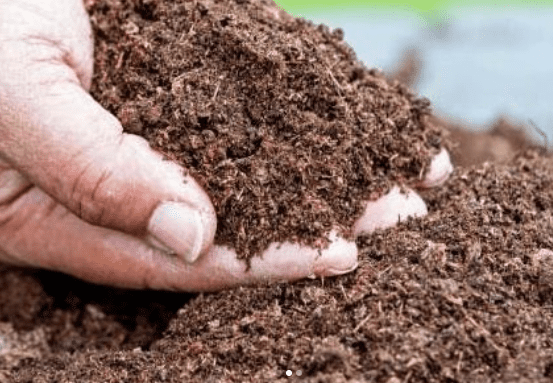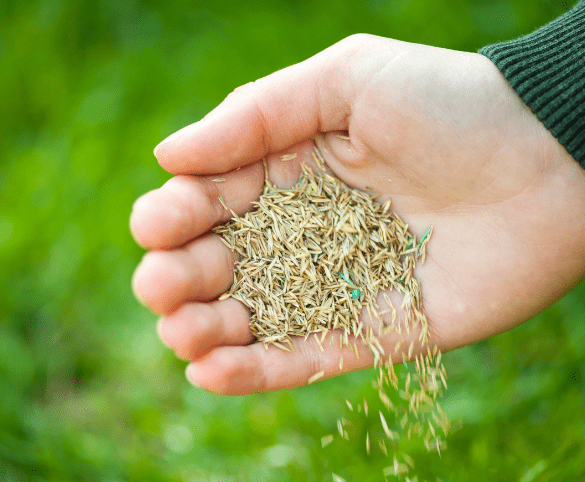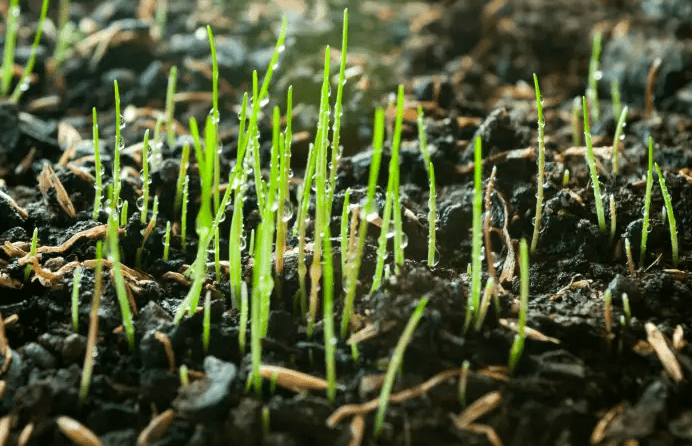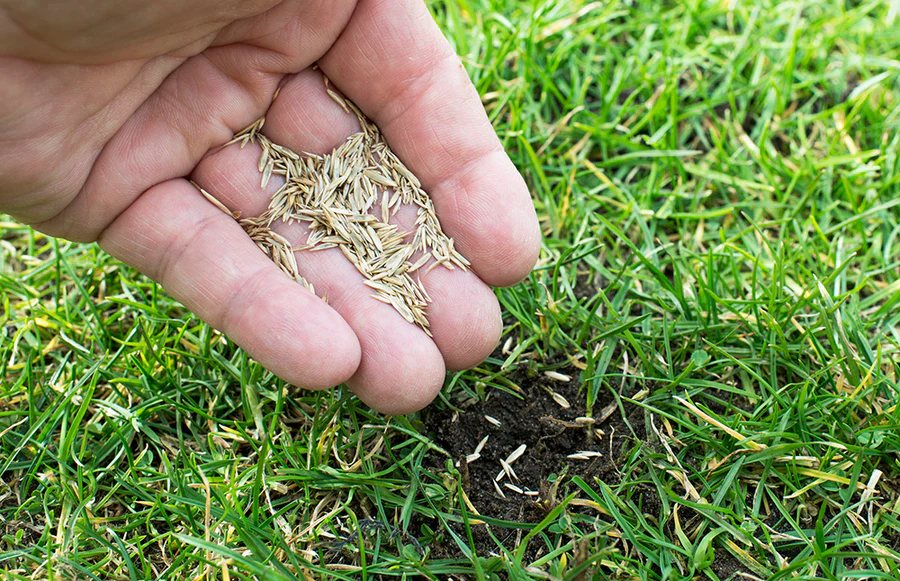Hello, I’m Sara Hameed, a passionate gardener and lawn care enthusiast with 9 years of experience. I’ve seen firsthand the power of organic materials like manure to transform lawns into lush, green havens. And one question I often get is, “Can you plant grass seed with manure?” The short answer is yes, but it requires careful planning and execution to get the best results.
Manure has been used as a natural fertilizer for centuries, known for its ability to enrich soil and promote plant growth. While it can be a fantastic addition to your lawn care routine, there are some crucial factors to consider when using it with grass seed. In this comprehensive guide, we’ll delve into the benefits, methods, and best practices for using manure to give your grass the best possible start.
People Also Read: Growing Plants Along a Vinyl Fence for Curb Appeal
Why Use Manure for Grass?
Manure isn’t just a byproduct of livestock – it’s a treasure trove of nutrients that can revitalize your lawn. Here’s why it’s so beneficial for grass:
- Nutrient-Rich: Manure is packed with essential nutrients like nitrogen, phosphorus, and potassium, all of which are crucial for healthy grass growth. Nitrogen promotes vibrant green growth, phosphorus strengthens roots, and potassium enhances overall plant health.
- Improves Soil Structure: When added to soil, manure acts like a natural conditioner, improving its texture and water-holding capacity. This is particularly helpful for sandy or clay soils that struggle to retain moisture and nutrients.
- Natural Source of Organic Matter: Unlike synthetic fertilizers, manure provides a natural source of organic matter. This feeds beneficial microorganisms in the soil, which break down the organic matter and release nutrients in a form that plants can readily absorb.

Can You Plant Grass Seed with Manure?
While manure is an excellent fertilizer, it’s important to use it correctly to avoid harming your grass seed. Fresh manure should never be used directly with grass seed. Its high nitrogen content can burn the seed, causing it to die before it even has a chance to sprout. The heat generated during decomposition can also damage the seed and hinder germination.
The safest option is to use well-aged or composted manure. Composting breaks down the strong nitrogen compounds, making it safer for your grass seed. Composted manure provides a slow-release source of nutrients without the risk of burning your precious seedlings.
Steps for Planting Grass Seed with Manure
Here’s a step-by-step guide to effectively planting grass seed with manure:
- Prepare the Soil: Before you even think about adding manure, make sure your soil is ready for planting. Remove any weeds, debris, or rocks. Loosen the top few inches of soil to create a good seedbed. This will allow the grass seed to establish easily and ensure proper root development.
- Mix in Manure: Add a thin layer of aged or composted manure to the soil. Aim for a layer about 4-6 inches deep. Work the manure into the soil thoroughly, ensuring it’s evenly distributed. This improves soil structure and provides a steady supply of nutrients as your grass grows.
- Sow the Grass Seed: Spread the grass seed evenly over the prepared soil. Make sure to follow the recommended seed rate for your specific type of grass. This ensures you’re planting enough seed to cover the area adequately. Gently rake the seed into the soil to ensure good contact between the seed and the soil. This helps promote germination.
- Top-Dress with Manure: After sowing the seed, you can add a very light top-dressing of composted manure. Keep it thin, no more than ¼ inch thick. This helps retain moisture, protect the seed, and provide additional nutrients as the seedlings emerge. However, be careful not to smother the seed with too much manure.
- Water the Area: Water the area thoroughly after planting. This helps settle the seed into the soil and encourages germination. Continue to water regularly, keeping the soil consistently moist, until the grass is established. The frequency and amount of watering will depend on your local climate and the type of grass you’ve planted.

When to Put Manure on Grass
Timing is critical when using manure as a fertilizer. Applying it at the wrong time of year can lead to poor results or even harm your lawn. The ideal times for applying manure to your lawn are:
- Early Spring: As the weather starts to warm up, your grass begins to actively grow. Applying manure in early spring provides a nutrient boost, promoting strong, healthy growth throughout the season.
- Fall: In the fall, grass enters a period of active root growth, preparing for the winter months. Applying manure in the fall helps strengthen the roots, providing a solid foundation for the following year.
However, avoid applying manure during the hot summer months, especially if you’re using fresh manure. The intense heat combined with the high nitrogen content of fresh manure can burn your grass, causing damage and potentially killing it.
Can You Put Manure Over Grass Seed?
Yes, you can put manure over grass seed, but it’s crucial to do it correctly. A thin layer of well-composted manure can actually benefit your grass seed. It helps protect the seed from drying out, retains moisture, and provides a steady supply of nutrients as the seed germinates. However, applying too much manure or using fresh manure can smother the seed and prevent it from growing.

Tips for Applying Manure Over Grass Seed
- Use Compost: Always use composted manure, not fresh manure. Fresh manure can be too strong for delicate grass seedlings and may contain harmful pathogens.
- Apply a Thin Layer: Keep the layer of manure very thin, no more than ¼ inch thick. A thick layer can block sunlight from reaching the seed, preventing it from germinating properly.
- Water Regularly: After applying manure over grass seed, water the area consistently to keep the soil moist. This encourages germination and helps the seed absorb nutrients from the manure.
Will Grass Grow in Cow Manure?
Grass can grow in cow manure, but only if the manure is properly aged or composted. Fresh cow manure is too strong for grass and can damage or kill it due to the high levels of nitrogen and ammonia. However, composted cow manure is an excellent fertilizer for grass.
Composted cow manure improves soil structure, enhances water retention, and provides a steady supply of nutrients. It also promotes beneficial microbial activity in the soil, which supports healthy grass growth.

How to Use Cow Manure Effectively on Your Lawn
- Composting the Manure: Ensure that cow manure has been composted for at least six months to one year before applying it to your lawn. This reduces the risk of nitrogen burn and eliminates any harmful bacteria. You can compost it yourself or purchase composted cow manure from garden centers.
- Application: Spread a thin, even layer of composted cow manure over your lawn, ideally in the fall or early spring. Water the lawn thoroughly after applying manure to help it settle into the soil.
Advantages of Using Manure for Grass Seed
- Natural Fertilizer: Manure provides a natural, organic fertilizer that enriches the soil without the need for synthetic chemicals. This promotes a healthier lawn and reduces the risk of harming the environment.
- Soil Improvement: Manure improves soil structure, making it easier for grass roots to penetrate and absorb water and nutrients. This leads to deeper, stronger roots and a more resilient lawn.
- Water Retention: The organic matter in manure helps the soil retain moisture, reducing the need for frequent watering. This saves you time and money while promoting healthier grass growth.
- Sustainability: Using manure as a fertilizer is an eco-friendly way to recycle animal waste and reduce reliance on chemical fertilizers. This contributes to a more sustainable lawn care practice.
Disadvantages of Using Manure with Grass Seed
- Risk of Over-Application: Applying too much manure can lead to nutrient imbalances, nitrogen burn, or smothering of grass seed. This can damage or kill your grass, so always use manure in moderation.
- Odor: Manure, especially fresh manure, can have a strong odor. While this may not bother some homeowners, others find it unpleasant. Composted manure generally has a less offensive odor.
- Weed Seeds: Some manure, particularly fresh manure, can contain weed seeds. These can introduce unwanted plants into your lawn, requiring additional weeding efforts.
- Pathogens: Fresh manure can contain harmful pathogens. Always use composted manure to minimize this risk. Composting effectively eliminates most pathogens.

How to Store and Handle Manure
Proper storage and handling are crucial to prevent problems associated with manure, such as odor, flies, or the spread of pathogens. Here are some tips for managing manure:
- Store in a Dry Area: Keep manure in a dry, covered area to prevent it from getting too wet or attracting pests. You can use a bin, a pile covered with a tarp, or a compost bin.
- Compost It: Composting manure before using it on your lawn reduces the risk of nitrogen burn and eliminates harmful pathogens. It also turns the manure into a more nutrient-rich, readily available fertilizer.
- Use Gloves: Always wear gloves when handling manure to protect your skin and reduce the risk of contamination. This is especially important if you have any cuts or open wounds.
Conclusion
Using manure to fertilize your lawn can be a powerful way to promote healthy grass growth, but it requires careful application. Well-composted manure is an excellent choice for planting grass seed because it provides a natural source of nutrients and improves soil health. However, avoiding fresh manure is crucial as it can burn grass and introduce pathogens into your soil.
By following the right techniques, such as mixing manure into the soil, applying it at the right time, and using composted manure over grass seed, you can create the ideal conditions for a lush, vibrant lawn. When managed properly, manure is an eco-friendly, sustainable way to enhance your lawn and help grass seed thrive. Whether you’re planting a new lawn or maintaining an existing one, using manure can give your grass the boost it needs to grow strong and healthy.
FAQs
What are the best types of manure for grass seed?
Composted cow manure and composted horse manure are excellent choices for planting grass seed. They’re rich in nutrients and have been broken down to minimize the risk of nitrogen burn.
Can I use chicken manure for grass seed?
Chicken manure is very high in nitrogen and can be too strong for grass seed. It’s best to compost it for at least a year before using it on your lawn. Even then, it should be used sparingly.
How long does it take to compost manure?
Composting time varies depending on the type of manure and the composting method used. Generally, it takes at least six months to one year for manure to fully compost.
Can I use manure on a new lawn after sod is laid?
It’s best to avoid using manure directly on newly laid sod. The strong nitrogen content can damage the sod. Wait until the sod is well-established, then apply composted manure in the fall or early spring.
Can I use manure on a grass seed lawn during the summer?
It’s not recommended to apply fresh manure during the summer months. The high temperatures can cause nitrogen burn and damage your young grass. If you must use manure, use a very light layer of composted manure in the evening hours.
Can I use manure on a lawn that is already established?
Yes, you can use composted manure on an established lawn to provide nutrients and improve soil health. Apply a thin layer in the fall or early spring.
How much manure should I use per square foot?
The amount of manure you use will depend on the type of manure and the nutrient content of your soil. Generally, a layer of 1-2 inches of composted manure is sufficient for most lawns.
How often should I apply manure to my lawn?
Applying manure once or twice a year is usually enough for most lawns. You can apply it in the fall or early spring.
What are the signs of nitrogen burn on grass?
Signs of nitrogen burn include yellowing or browning of the grass blades, wilting, and stunted growth. If you suspect nitrogen burn, stop using manure and water the lawn thoroughly.
Is it ok to use manure on a lawn that is shaded?
Yes, you can use composted manure on a shaded lawn. However, be careful not to over-apply it, as shaded lawns may have slower decomposition rates.
I hope this guide has been helpful. If you’re interested in learning more about tech news, feel free to visit my website: www.HowToGrowPlant.com. Happy gardening!

